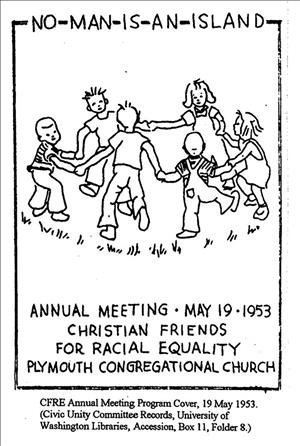The Christian Friends for Racial Equality (CFRE) was a pioneering civil rights organization in Seattle from 1942 through 1970. The interracial and interfaith group sought education and social interaction to combat racial discrimination. This non-confrontational approach made the group popular among people interested in racial harmony, but the shift in the civil rights movement to legal and direct action in the 1960s left the CFRE's methods relatively ineffective.
Beginning in 1940, the Pacific Northwest shared in the economic boom of World War II. Defense workers, including thousands of African Americans from the Old South, crowded into Seattle competing for jobs and housing. Prior to this time, the small proportion of minorities had given Seattle a reputation as having good race relations. Minorities did suffer housing and job discrimination as well as restrictions from some recreational activities, but they largely enjoyed equal access to restaurants and businesses. With the changes brought by the war, citizens became concerned about inequality.
The groups that started working during the war to combat racial inequality and to foster better race relations in Seattle included the Young Men's Christian Association (YMCA), the American Friends' Service Committee (AFSC), the Race Relations Department of the Seattle Council of Churches, and the Anti-Defamation League. The National Association for the Advancement of Colored People (NAACP), the Japanese American Citizens League (JACL), and the Seattle Urban League saw memberships increase.
On May 19, 1942, 17 people from seven Christian denominations and the Jewish faith gathered to form the Christian Friends for Racial Equality (CFRE). It was a self-governing group whose purpose was "to welcome all people to our churches, and to strengthen those bonds which unite us all as one people in our democracy." The CFRE worked against discrimination through social contacts and "the procedures of investigation, persuasion, and when advisable, by publicity to foster equality and understanding" (McClees).
In 1944, the CFRE contributed to the formation of the Civic Unity Committee by writing to Mayor William F. Devin (1898-1982) asking him for a "City Interracial Committee." Although the CFRE formed too late to affect the internment of Japanese Americans in 1942, they worked to smooth their return after the war.
The emphasis on non-confrontation and on social activities was popular and the group grew to 500 members in four years. The group was able to attract many popular community leaders to its membership. By 1956, it was the largest interracial civil rights organization in Seattle. Many CFRE members were also members of other civil rights groups. The CFRE was unique insofar as it stressed social contacts such as theater outings, small teas and luncheons, picnics, nature walks, folk dances, and art classes as a means of furthering cross-cultural understanding.
Soft Sell
Despite the name, many Jews were attracted to the group. Women made up approximately two-thirds of the membership and almost three-quarters of its officers. Most of the active male members were retirees.
The group took a conservative approach to activism and did not involve itself in direct actions such as sit-ins or rallies. In the 1940s, the CFRE became involved in open housing by fighting restrictive covenants in neighborhoods. In the 1950s, it began asking ministers to encourage property owners to rent or sell to minorities.
A 1959 survey of the African American community in Seattle showed the CFRE to be the third most influential civil rights group behind the Urban League and the NAACP. Members wrote at least one letter a week to legislators and government and business leaders condemning discrimination or congratulating them on their anti-discrimination efforts. Members also personally approached business owners who practiced discrimination to ask them to open their doors to all. A speakers' bureau was very active. The CFRE even battled discrimination in Seattle's cemeteries.
The Movement Changes
In the early 1960s, membership and meeting attendance began to decline. Other organizations had adopted the CFRE's work and the civil rights movement had changed. Discrimination was being battled in the legislatures and courts and polling places instead of in parlors and church halls.
In 1966, the CFRE members decided to close its office. The CFRE ceased to function sometime after 1970, the last year its records are available.

